Israeli salad is a dish that is ever-present in my kitchen. It’s easy to make, inexpensive, and surprisingly delicious. In summer, I serve it alongside grilled fish or kebabs. In colder weather, I use it as a healthy side to lighten up heavy meals. I also serve it with breakfast sometimes, it goes great with an herby egg and cheese omelette!
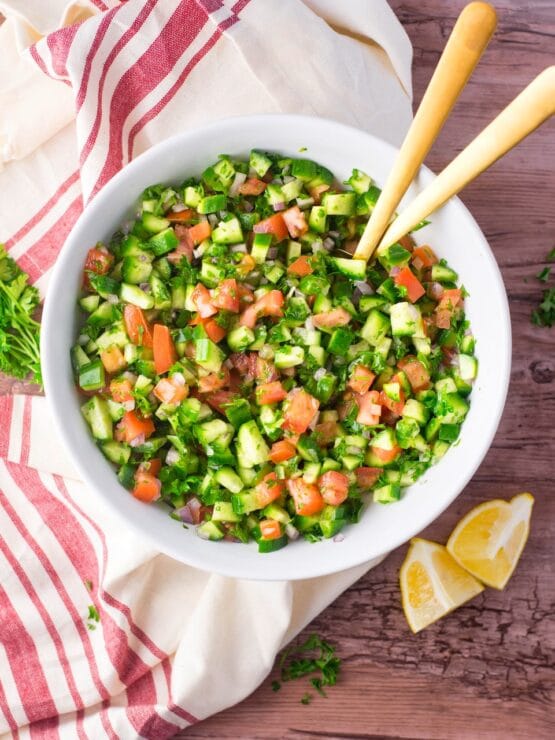
For those of you who aren’t familiar with Israeli Salad, here’s a little background. It evolved from a Turkish salad known as shepherd’s salad – coban salatsi, which is closely related to a Persian salad known as salad shirazi, named for the ancient city of Shiraz. The salad is known under different names with slight ingredient variations throughout the Middle East.
When Jews began making aliyah to Israel in the late 1800′s, coban salatsi from Israel’s Turkish neighbors became popular on the kibbutzim (communal agricultural collectives) because of the simple, easy-to-grow ingredients– cucumbers, tomatoes, onions, peppers, and parsley. Over time, ingredients were added or taken away, but the basic components remained the same: cucumbers and tomatoes dressed in olive oil, lemon juice, and salt. The vegetables are always diced; the size of the pieces varies depending on personal preference. Some cooks prefer to dice the vegetables very small, a practice that started in the Ottoman Empire. Other cooks prefer a more chunky texture. I like it both ways.
Although this salad has different names throughout the Middle East, my family refers to it as Israeli salad because of my husband’s Sephardic background. It is a refreshing side dish that complements all kinds of main dishes. It is low in calories, dairy-free, and can be served with any meal– even breakfast!
Each ingredient in the salad has unique health benefits. Fresh Persian cucumbers (peel on) are fat-free, full of water, and a good source of fiber. Fresh tomatoes provide Vitamin C, A, and cancer fighting lycopene (organic tomatoes provide up to three times the lycopene of non-organic!). Onions are rich in chromium, a trace mineral that helps cells respond appropriately to insulin. Onions can lower blood sugar levels, and they’ve also been shown to help lower cholesterol and blood pressure. Fresh parsley is a great source of Vitamin K. It also contains Vitamins C and A, Folate, and anti-oxidants. Lemon juice is full of Vitamin C, antioxidants, and potassium. It’s also a natural diuretic. Olive oil provides a healthy dose of MUFA’s (mono unsaturated fatty acids) and can help with digestion.
One of the main ingredients in Israeli salad is Persian cucumbers. Smaller and sweeter than English cucumbers, they are great for snacking. Here’s what they look like:
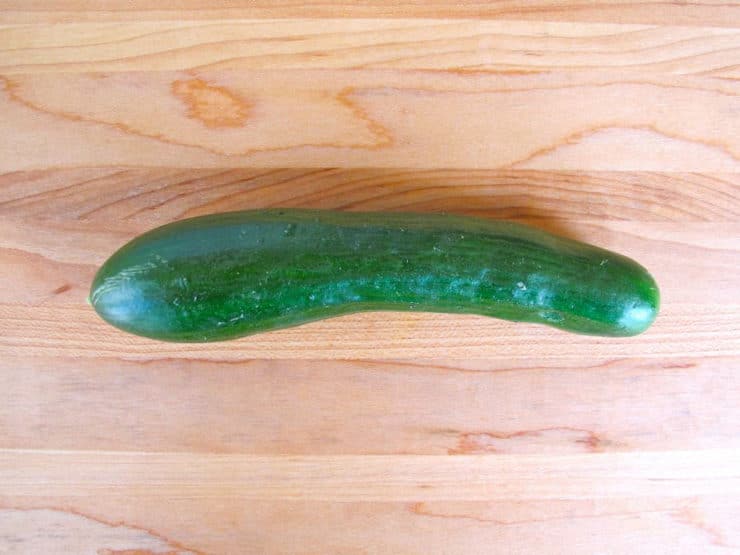
Cute, huh? I’m a big fan of these little guys. If you can’t find Persian cucumbers, you may substitute English cucumbers—those are the long thin ones wrapped tightly in plastic. Avoid using regular fat cucumbers, as they are coated with wax and prone to bitterness.
There are many creative variations on Israeli Salad; I’ll link to a few of my favorites below. I try to use seasonal produce in my cooking, and I often experiment with whatever looks freshest in the vegetable section or at the farmer’s market. Adding seasonal or regional ingredients can really “spice up” your Israeli Salad.
Before I get into variations, here’s a recipe for a simple Israeli Salad. I don’t like raw onion, so I often make mine without. Our family enjoys it both ways. Be sure to dice the vegetables small and evenly– I’ve given my tips for slicing Persian cucumbers below.
Other Israeli Salad Recipes
Israeli Salad with Pickles and Mint
Israeli Salad with Avocados and Mint
Recommended Products:
We are a participant in the Amazon Services LLC Associates Program, an affiliate advertising program designed to provide a means for us to earn fees by linking to Amazon.com and affiliated sites. As an Amazon Associate I earn from qualifying purchases.
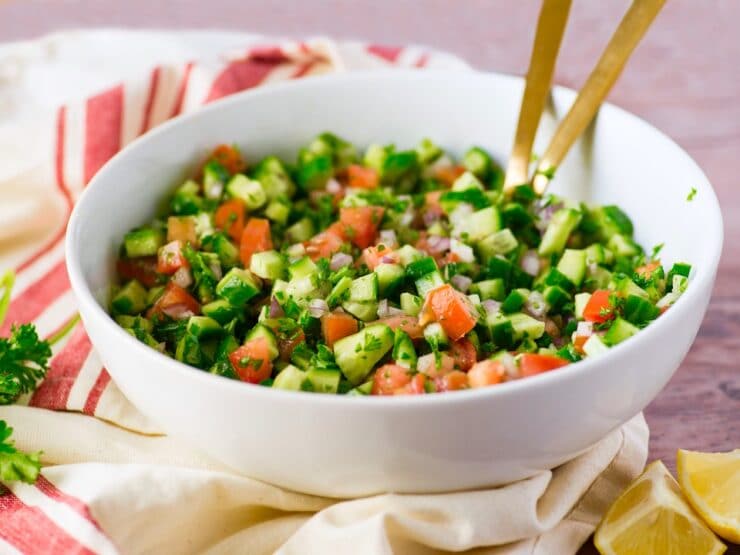
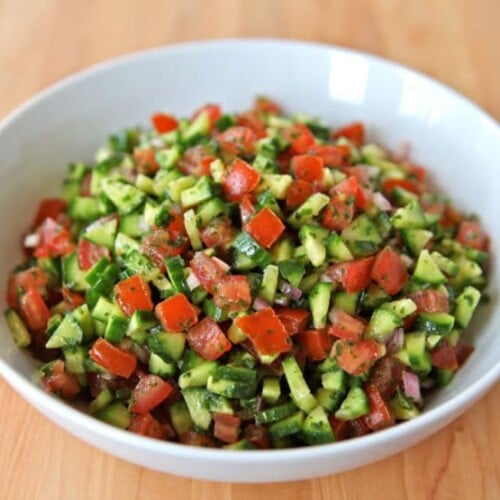
Israeli Salad
Ingredients
- 1 pound Persian cucumbers, diced
- 1 pound fresh ripe tomatoes, seeded and diced
- 1/3 cup minced onion (optional)
- 1/2 cup minced fresh parsley
- 3 tablespoons extra virgin olive oil
- 3 tablespoons fresh lemon juice
- Salt to taste (I use about 1/2 tsp)
Instructions
- Here is the way I like to dice the Persian cucumbers-- it produces small, even, triangular pieces. Slice the Persian cucumber in half lengthwise.

- Slice each half into 4 slices lengthwise, so you have 8 long, thin pieces total.

- Hold the long, thin pieces together with one hand, and slice the bunch into very small pieces with the other hand. Note: Persian cucumbers have lots of little seeds, which add to their flavor. If you have trouble digesting seeds, you can seed the cucumber easily by slicing it in half lengthwise and scooping out the seed-filled center.

- Place the diced cucumbers into a large mixing bowl along with all the other ingredients.

- Mix until vegetables are well coated with parsley, oil, lemon juice, and salt.

- Best served fresh at room temperature. You can also serve chilled for a more refreshing salad.

Nutrition

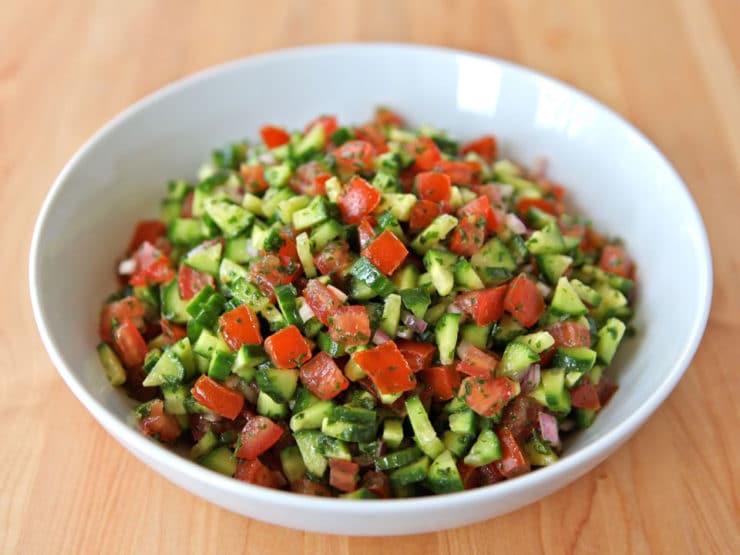
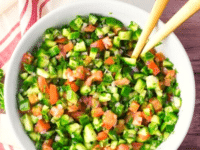
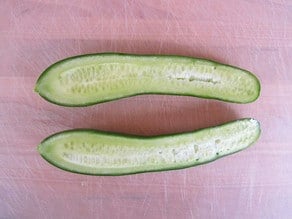
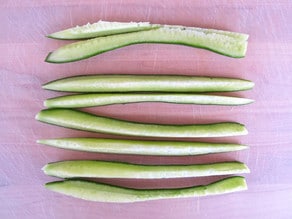
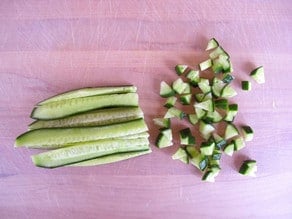
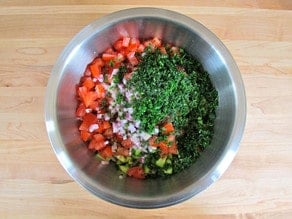
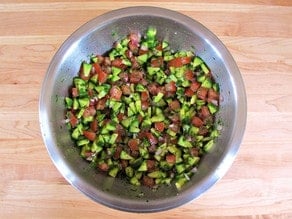
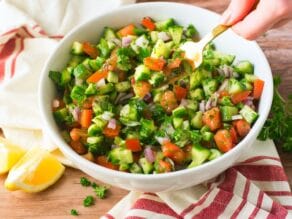


Tori,
Thank you for the recipe. I just got back from Israel and really enjoyed this salad with wonderful Israeli breakfasts and dinners. I am now enjoying it it at home. I also brought some fragrant Galilee zatar and would like some hints on what to use it with.
Thank you,
Ursula
I add it to the Israeli salad and I sprinkle it on chicken peas and roast them in my air fryer for a crunchy snack
We love this recipe! I couldn’t remember the name and had to ask my daughters if they remembered as it had been a while since I had made it. I am glad I was able to find it again! I need to keep this recipe handy.
I put chickpeas in this salad and put it in whole wheat pitas
What a great idea! It’s makes a complete meal.
Also I like to add some Israeli zapata. Very good!
I love this recipe because it’s just like the classic salad my father made who passed away when I was 10. I use this recipe now whenever I make it! 😊
Simple, quick and healthy accompaniment to any meal
I made the Israeli salad and it was decilicious! Easy to make too 🙂
I made it the other day for lunch and it was delicious and so easy to make! It’s a keeper!
Had this salad when I visited Israel and Jordan last year. It’s wonderfully refreshing and goes pretty much with anything. Love it!
Sitting at home wondering what do make for dinner and then I remember it’s Yom HaAtzmaut. So I whip up some hummus and pull the leftover bunch of parsley from Passover, the other half of cucumber from last night’s salad, a tomato, onion, a lemon that fell off my tree, and some olive oil and salt and POOF – a celebration meal! I also picked some mint and copped that up for the salad — very nice!
Thanks so much for sharing, I was in love with the village salad. I found this salad so much better. I made enough for a party of 15 and they raved over it. Thanks again making tonight for my daughter the mint version. I also love that you shared your story.
I love this salad! It is one of my favourites! We worked in Lybia for 5yrs. and there they called this Lybian salad and used cilantro in place of parsley at times. I love it with cilantro and a bit of mint. Actually you can find this salad all over North Africa! I have relatives in Israel and when we visited we often had it on the breakfast table.
Yes, you can find it all over the Middle East and North Africa under various names. It is delicious, and so fresh!
Thank you for this beautiful salad, I think every culture has a variation of this! I have worked with wonderful people from Turkey, and they introduced me to some of their food, lucky me! I will be making this delicious salad today! Again, Thank you.☘️
This salad is popular in the Southern US. However, most people use Italian salad dressing in place of the olive oil and lemon juice. And the veggies are roughly chopped instead of diced small.
I don’t like raw onions, either. However, Vidalia onions work well in this salad. They’re not pungent.
This was delicious! I used English cucumbers since I had them on hand, and no onion. I’m already looking forward to making it again. Thanks for the great recipe!
We’ve been getting mini English cucumbers for ages, they’re less expensive and great alone as a snack. I just use salt and pepper with red balsamic vinegar but will definitely try some of your ideas.
After a 2018 trip to Israel, where we ate this salad every day for breakfast (yes, breakfast!) and for dinner, I became obsessed with making it at home. It is so easy to make and so refreshing to eat! I do not use anything in mine except for cucumbers, tomatoes, salt to taste, and equal parts lemon juice and olive oil. It is the perfect side dish with any entree. Thanks for sharing your recipe!
I really enjoy the history section of the recipes, the evolution of a dish over time is fascinating the me. Thanks a bunch!
I practically live off this salad in the summertime. I never knew it had a name; I just made it with my garden veggies! I like to add in a crushed clove of garlic, kalamata olives, and some dried mint. YUM.
I added croutons (a few olive oil drops on a slice of bread, tore it up and baked it in oven). My husband added a bit of feta, my 10 year old had the salad justvwith croutons
I don’t eat raw tomato so I will swap it for red capsicum.
Very delicious. So easy to make and terribly addictive, which is fine because it gets my family to eat their veggies! I used cilantro instead of parsley for a fresher taste and I like to stir in a little crumbled feta unless I’m making a meat meal.